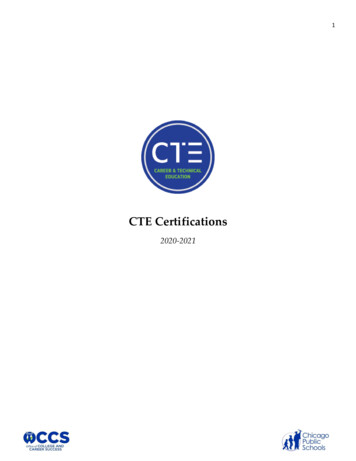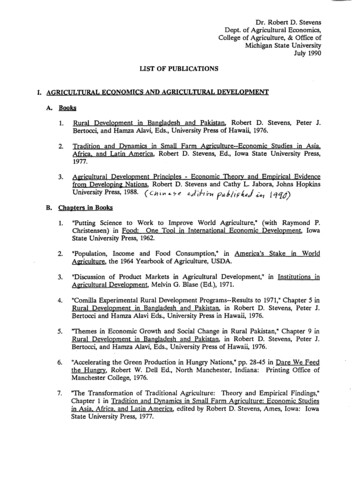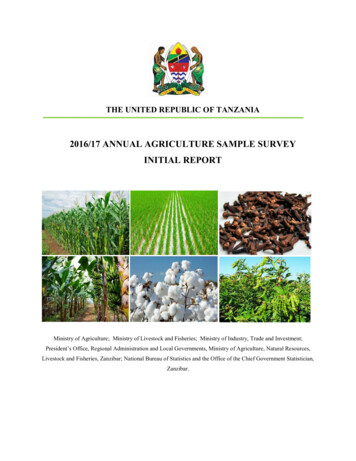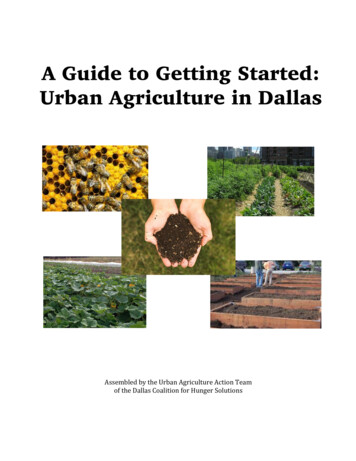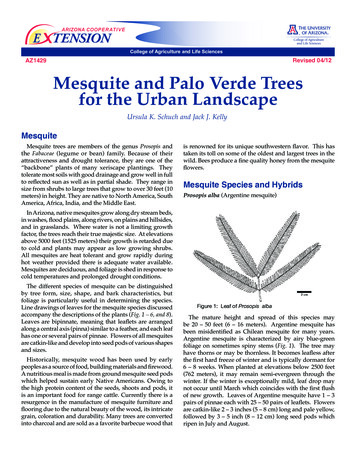
Transcription
ARIZONA COOP E R AT I V EE TENSIONCollege of Agriculture and Life SciencesRevised 04/12AZ1429Mesquite and Palo Verde Treesfor the Urban LandscapeUrsula K. Schuch and Jack J. KellyMesquiteMesquite trees are members of the genus Prosopis andthe Fabaceae (legume or bean) family. Because of theirattractiveness and drought tolerance, they are one of the“backbone” plants of many xeriscape plantings. Theytolerate most soils with good drainage and grow well in fullto reflected sun as well as in partial shade. They range insize from shrubs to large trees that grow to over 30 feet (10meters) in height. They are native to North America, SouthAmerica, Africa, India, and the Middle East.is renowned for its unique southwestern flavor. This hastaken its toll on some of the oldest and largest trees in thewild. Bees produce a fine quality honey from the mesquiteflowers.Mesquite Species and HybridsProsopis alba (Argentine mesquite)In Arizona, native mesquites grow along dry stream beds,in washes, flood plains, along rivers, on plains and hillsides,and in grasslands. Where water is not a limiting growthfactor, the trees reach their true majestic size. At elevationsabove 5000 feet (1525 meters) their growth is retarded dueto cold and plants may appear as low growing shrubs.All mesquites are heat tolerant and grow rapidly duringhot weather provided there is adequate water available.Mesquites are deciduous, and foliage is shed in response tocold temperatures and prolonged drought conditions.The different species of mesquite can be distinguishedby tree form, size, shape, and bark characteristics, butfoliage is particularly useful in determining the species.Line drawings of leaves for the mesquite species discussedaccompany the descriptions of the plants (Fig. 1 – 6, and 8).Leaves are bipinnate, meaning that leaflets are arrangedalong a central axis (pinna) similar to a feather, and each leafhas one or several pairs of pinnae. Flowers of all mesquitesare catkin-like and develop into seed pods of various shapesand sizes.Historically, mesquite wood has been used by earlypeoples as a source of food, building materials and firewood.A nutritious meal is made from ground mesquite seed podswhich helped sustain early Native Americans. Owing tothe high protein content of the seeds, shoots and pods, itis an important food for range cattle. Currently there is aresurgence in the manufacture of mesquite furniture andflooring due to the natural beauty of the wood, its intricategrain, coloration and durability. Many trees are convertedinto charcoal and are sold as a favorite barbecue wood thatFigure 1: Leaf of Prosopis albaThe mature height and spread of this species maybe 20 – 50 feet (6 – 16 meters). Argentine mesquite hasbeen misidentified as Chilean mesquite for many years.Argentine mesquite is characterized by airy blue-greenfoliage on sometimes spiny stems (Fig. 1). The tree mayhave thorns or may be thornless. It becomes leafless afterthe first hard freeze of winter and is typically dormant for6 – 8 weeks. When planted at elevations below 2500 feet(762 meters), it may remain semi-evergreen through thewinter. If the winter is exceptionally mild, leaf drop maynot occur until March which coincides with the first flushof new growth. Leaves of Argentine mesquite have 1 – 3pairs of pinnae each with 25 – 50 pairs of leaflets. Flowersare catkin-like 2 – 3 inches (5 – 8 cm) long and pale yellow,followed by 3 – 5 inch (8 – 12 cm) long seed pods whichripen in July and August.
Prosopis chilensis (Chilean mesquite)trunk is tan and smooth when young but becomes rougherand darker as the tree matures. Texas honey mesquite isnative to the southwestern U.S. including Texas, Oklahoma,Kansas and into northern Mexico.Due to its ornamental popularity, several selectionshave been made for foliage, form and thornlessness. Thesecultivars are vegetatively propagated to insure the integrityof the clone. Texas honey mesquites require well drainedsoil and tolerate full sun or partial sun. Once established,plants irrigated monthly develop into larger trees with adense canopy.Figure 2: Leaf of Prosopis chilensisThis mesquite is characterized by a lacy crown of bluegreen foliage on spiny stems (Fig. 2). Spines may be upto 2 inches (5 cm) in length which may limit its use inresidential or high traffic areas. The trunk is typically darkbrown and fissured. In the low and mid-desert, below2,500 feet (762 meters), the tree will lose most of its foliageexcept in years of mild winter temperatures when foliagemay remain on the tree until March. Old leaves do not fallfrom the tree until new growth is well underway. Duringcold winters the tree will be dormant and leafless for 6– 8 weeks during winter. New foliage will appear in lateMarch or early April and is fern-like and a beautiful lightgreen. Leaves are characterized by 1 – 3 pairs of pinnaeeach with 10 – 29 pairs of widely spaced leaflets. Flowersare 1 – 3 inches (2.5 - 7.6 cm) in length and light yellow.Flowers are followed by 2 – 5 inch (5 – 13 cm) bean podsthat ripen in July.Prosopis glandulosa var. glandulosa (Texas honey mesquite)Figure 4: Leaf of Prosopis glandulosa var. torreyanaP. glandulosa var. torreyana is similar in character to Texashoney mesquite, but has smaller leaves with one pair ofpinnae and 8 – 24 pairs of leaflets per pinna (Fig. 4). It isnative to west Texas, California, New Mexico and parts ofArizona and Mexico. This variety can sometimes be foundin nurseries.Prosopis nigra (Black mesquite, Algarrobo negro)Figure 3: Leaf of Prosopis glandulosa var. glandulosaThis attractive ornamental tree grows to a mature heightof 15 – 30 feet (5 – 10 meters) and is characterized by itsweeping habit and shiny foliage which resembles Schinusmolle (California pepper tree). It has small reddish thornsand creamy white flowers. Leaves have 1 – 2 pairs of pinnaewith 6 – 17 pairs of secondary leaflets per pinna (Fig. 3). The2The University of Arizona Cooperative ExtensionFigure 5: Leaf of Prosopis nigra
P. nigra is native to Argentina, Paraguay and parts ofUruguay. It resembles P. alba in many respects and hasvery similar form and foliage (Fig. 5). The leaflets of P. nigraare closely packed in dark green compound leaves. Leaveshave 1 – 3 pairs of pinnae with 20 – 30 pairs of leaflets perpinna. Trunk color is dark brown to black. Unlike manymembers of the Prosopis genus, black mesquite is evergreenunder most conditions. The plant form is quite variableand may be heavily thorned. With deep soil and adequatemoisture the tree may grow to 30 feet (10 meters) in heightand width. It will tolerate being grown in irrigated turfareas and full-sun exposure. The wood is prized becauseof its beautiful brown streaking and is used to makefurniture and barrels. Flowers are typical catkin-like up to2.5 inches (6 cm) long and yellow, and are followed by seedpods that are 4 – 6 inches (10 – 15 cm) long and are oftenstreaked with pink. P. nigra is currently underused as itis not commonly available in the trade, although it is anexcellent tree for the low and mid-elevation desert.Prosopis velutina (Velvet mesquite)Prosopis pubescens (Screwbean mesquite, Tornillo)Figure 7: Prosopis velutina in winter (above) and spring(below)Figure 6: Leaf and seed pod of Prosopis pubescensScrewbean mesquite grows to about 25 feet (7.6 meters)with an equal spread. P. pubescens is native to the Sonoranand Chihuahuan deserts in parts of southern Arizona,Texas, and New Mexico. The tree is characterized byunique seed pods that appear as a tightly wound spring ora screw, hence the common name (Fig. 6). “Tornillo” meansscrew in Spanish. The tree is typically multi-stemmed andthe bark on older branches is shaggy, flaky and easilypeels from the tree. Typical form of the tree is vase-like,very open and spreading. The leaves are smaller than theother mesquites described above and are characterized byone pair of pinnae with 5 – 9 pairs of leaflets per pinna.Each leaflet is approximately 3/8 to 1 inch (1 – 2.5 cm) inlength (Fig. 6). The small ¾ inch (2 cm) spines are whitish,slender and appear as pairs along the branches. Catkinlike flowers are bright yellow. This tree grows very slowlywithout irrigation.Figure 8: Leaf and seed pod of Prosopis velutinaMature size of velvet mesquite is 30 – 50 feet (9 – 15 meters)height and spread (Fig. 7) when grown with adequate waterand in deep soils. Growth rate is slow to moderate butmoderate to rapid under irrigation. Velvet mesquite isThe University of Arizona Cooperative Extension3
native from central and southern Arizona into Mexico. Itgrows as a shrub on dry rocky upland sites but will growmuch larger under ideal conditions. This tree may befound as a single-stemmed tree in bosques (thickets) or asa multi-stemmed tree in open areas. The bark is fissured,dark brown and rough. The wood is prized for furniturebecause of its unique coloration and intricate grain. Treesmay grow up to 4 feet (1.2 meters) in trunk diameter andlive for several hundred years. Velvet mesquite foliage iscovered with dense short gray hairs that cover most partsof a younger plant (Fig. 8).CultureFiltered shade from velvet mesquites is light and oftenserves as a nurse tree for other slower growing plants suchas cactus and shrubs. Leaves have one or two pairs ofpinnae (Fig. 8) with 12 – 30 pairs of leaflets each. In latefall or early winter after the first hard freeze, the graygreen, fine textured leaflets turn light green or tan and fallfrom the tree revealing a beautifully sculptured trunk andscaffold branches. In spring two to three inch (5 – 7.5 cm)long cream-colored flowers adorn the tree followed bytan seed pods which ripen in mid to late summer. Youngvelvet mesquites have small thorns which become lessproblematic as the tree matures. Velvet mesquite trees aredrought tolerant yet will flourish with moderate irrigation.They may become unstable due to rapid crown growthand a limited root system in lawn conditions.All mesquites are very tolerant of hot south and westfacing walls, are valuable trees in parks or large publicareas, and are an asset in low water-use landscapes. Theymay be planted in groups or as solitary specimens andadd a lush appearance to the landscape. Mesquites arewell suited to heat, low humidity, alkaline and poor soils.Mesquite trees are not well suited as street trees due to theirmulti-trunk character. The cold tolerance of many specieshas been established but this tolerance is quite variableowing to the condition of the plant at the onset of winter.Heavily fertilized and irrigated trees will not tolerate thecold as well as those that have been conditioned with lesswater and no fertilizer late in the summer. Honey mesquite(Prosopis glandulosa) and screwbean mesquite (P. pubescens)can survive temperatures to 0 ºF (–18 ºC); velvet mesquite(P. velutina) is reliably cold hardy to at least 10 ºF (–12 ºC);Chilean mesquite (P. chilensis) and black mesquite (P. nigra)are hardy to at least 15 ºF (–9 ºC); Argentine mesquite (P.alba) and many South American hybrids suffer damageand dieback when temperatures fall below 15 – 20 ºF (–9 to–7 ºC). Where there is abundant water present, mesquitespecimens will be largest when grown in deep, uniform,sandy soils in and along streambeds, and alluvial plains.With proper irrigation, these trees will grow satisfactorilyon any well drained soil.Hybrid mesquitesProblemsMesquites cross-pollinate quite readily and as aresult there are a group of plants that are simply called“hybrid mesquites”. They are often the result of naturalhybridization of Prosopis alba (Argentine mesquite), P.chilensis (Chilean mesquite) and native P. velutina. Becauseof this hybridization, it is almost impossible to obtain purespecies seed. Most hybrids are typically fast-growing,attractive, thorny or thornless, may have delicate bluegreen or green foliage or may have small leaves and haveintermediate characteristics of the above described species.Many of the hybrid mesquite leaves persist until the newgrowth begins in spring, giving the tree an almost evergreenappearance. These hybrids are often sold in the trade as“Chilean” mesquite or “South American Hybrids”.Hybrid mesquites are noted for their rapid growth andcan attain a mature height of 9 – 40 feet (3 – 13 meters) witha spread of up to 30 feet (9 meters). They make an excellentlarge shade tree but given their size, are often unsuitedfor the smaller yards found in newer subdivisions. Manyhomeowners seek out the thornless hybrids and as a result,selections of trees having no thorns and superior structuraland aesthetic characteristics have been made. To preservethese characteristics, trees either are grown from cuttings,are air layered, or are grafted. Thorns, which are modifiedleaves, often disappear as the tree matures. In situationswhere thorns (which can be up to 2 inches (5 cm) long) areobjectionable, they may be pruned off young trees and willnot re-grow from this location again.4The University of Arizona Cooperative ExtensionFigure 9. True mistletoe aerial shoots with berries.There are few problems of mesquites. Mistletoe(Phoradendron californicum) can be a nuisance or developinto a more serious problem for heavily infested trees.True mistletoe contains chlorophyll and carries onphotosynthesis, but being a parasite it also lives off thenutrients of the host plant (Fig. 9). It can develop intoplants that are several feet in diameter. Mistletoes may be aproblem if left unmanaged and while it generally does notkill a tree, it can cause significant decline over time. If notpruned out, the weight of the mistletoe can become greatenough that the branch may break off. Manual removal
of mistletoe is the only practical control however, removaldoes not kill the mistletoe as it continues to grow inside thewood. Since mistletoe is a part of the desert ecology, it isan aesthetic decision whether to remove it or not on lightlyinfested trees. Mistletoe berries are a primary food sourceof desert birds and only in few situations the mistletoebecomes large enough to warrant removal.Figure 10: Slime flux on Prosopis sp.Slime flux is caused by the infection of sapwood byseveral bacteria and is a problem with mature mesquites.The disease causing microorganisms are found in the soiland probably gain entry through above or below the soilline wounds or pruning cuts. After several years, affectedareas will exhibit a water-soaked appearance (wet wood).Gas is produced by the bacteria (and possibly yeasts) whichforce out a foul smelling liquid from cracks and wounds.The liquid is dark brown to black in color (Fig. 10). Infectedtrees live many years and slime flux is more of a nuisancethat requires periodically a strong, hard stream of waterto prevent staining of patios and cars. Seriously infectedbranches may need removal if they present a safety hazard.The old remedy of placing drainage tubes into the infectedareas is not recommended and may in fact, present moreentry sites for the disease.Figure 11: A shelf-shaped mushroom of a wood decay fungus(Ganoderma sp).Ganoderma root rot (Ganoderma) is caused by a soilborne fungus and enters mesquite roots primarily throughwound sites. Root rot causes slow decline and eventuallydeath of mature trees. There is no recommended treatmentfor infected trees. Fruiting bodies at the base of the treeare most common during the summer rainy season. Theystart as white structures at the base of the tree and developinto light brown, shelf like fruiting bodies (Fig. 11).Figure 12: Nymph of giant mesquite bug(Thasus neocalifornicus)During the summer months, the giant mesquite bug(Thasus gigas) makes its appearance. Although it looksthreatening because of its size and dramatic markings, itis just another insect that is part of the desert ecology. Nocontrol is recommended for these insects as their damageis minimal. The adults are up to two inches (5 cm) longand have brown and yellow markings on their forewingsand red and black banding on their legs. What makes theseinsects interesting is that the immature insects (nymphs)are banded an attractive red and white and may appear inlarge numbers in early April (Fig. 12). Although menacinglooking, they are not considered a damaging pest ofmesquites.Another minor pest of mesquite is the mesquite twiggirdler (Oncideres rhodosticta) which may appear in early tomid-summer. The adult cuts a channel around the stem anddeposits her eggs in now girdled portions. The resultingdamage is “flagging” or browning of the girdled stems.Since the damage is cosmetic, no control is recommended.Miscellaneous wood borers may appear from time to timein older, neglected or stressed trees. These beetles aretypically drawn to trees that are under severe stress andare considered secondary pests.Irrigation related issues can cause problems formesquite trees or surrounding vegetation. Infrequentshallow watering for turf will encourage surface rootingrather than the deep root development that properirrigation of trees will provide. Mesquite trees can becomeunstable with excess irrigation, such as in lawns, due torapid crown growth and limited root system development.The University of Arizona Cooperative Extension5
Another irrigation related problem is improper placementof drip emitters. By placing emitters close to the trunk,roots primarily develop in these areas. Placing the emittersfurther out (at the dripline of the tree and beyond) will helpestablish a root system which gives stability to the tree andreduces the occurrence of tree toppling and possible treeloss.Root binding can be a problem of mesquite and paloverde trees when purchased in containers. Most mesquitebut also some of the palo verde species grow very fastunder cultivation. If not transplanted to larger containersin a timely manner, roots start circling around the outsideof the root ball and in some cases close around the trunk.If not corrected by pruning circling roots at transplanting,this condition can lead to problems of tree failure.presented with each species to aid in identification (Fig. 14,15, 17 – 19).Palo verde plays an important role in the desert ecosystemproviding habitat for wildlife and serving as a nurse plantfor small cacti. Flowers produce much nectar for honey.Pods are sought by wildlife and livestock and provided astaple for indigenous people in the Southwest. Pods cancreate heavy litter.Parkinsonia aculeata (Mexican palo verde) is found inolder landscapes, but is no longer considered a desirablelandscape tree. Although a showy blooming tree, it is wellarmed, short-lived, produces heavy leaf litter, and reseedsfreely on road sides, vacant lots, and in washes.Parkinsonia florida (Blue palo verde)Palo Verde Species and CultivarsFigure 13: Profuse bloom on Parkinsonia floridaPalo verdes are popular, drought tolerant landscape treesin the genus Parkinsonia (formerly Cercidium) and the familyFabaceae. Palo verdes range from large shrubs to mediumsized trees and are native in the Sonoran Desert except forP. praecox which is native from Mexico to South America.Along with saguaro cactus, they are a staple of the SonoranDesert and are used in many xeriscape plantings. Parkinsoniaflorida, blue palo verde, and P. microphylla, the Foothill paloverde, share the title of Arizona’s official state tree.Palo verde trees prefer full sun and well drained soil incultivated landscapes. Growth rates vary depending onsupplemental irrigation and species. Conspicuous green,smooth bark dominates the plant’s appearance duringperiods of drought and cold when trees are leafless and givesthem their common name “palo verde” which in Spanishmeans “green stick”. Shoots are armed with small thornsat the nodes or the end and leaves are small, bipinnate. Thegreen bark allows photosynthesis and with age turns fromsmooth with yellowish green color to rough with gray color.Besides the striking green bark, a profuse show of yellowflowers in spring makes palo verdes popular landscapetrees. Line drawings of leaves, flowers and seed pods are6The University of Arizona Cooperative ExtensionFigure 14: Leaf, flower and seed pod of Parkinsonia floridaThe blue-green color of stems, branches, and denselygrowing twigs and the prolific bright yellow flowers inspring (Fig. 13) have made it one of the most popular paloverde species. Foliage is fine textured and consists of onepair of pinnae with 2 – 4 pairs of leaflets (Fig. 14). Blue paloverde flowers in mid-spring, about three weeks earlier thanP. microphylla (Foothill palo verde). Blue palo verde has amoderate growth rate. It is adapted to desert soils, but canalso tolerate lawn conditions. Native to washes and plainswith deep soil, trees benefit from additional irrigation onceor twice during the hot, dry season. This plant is native tothe Sonoran Desert, northern Sinaloa and Baja California,Mexico, and can be found at elevations from sea level to4,000 feet (1,220 meters). Cold hardiness is reported to 10ºF (–12 ºC).
The profuse amount of flowers and seed pods can createheavy litter under the tree canopy. Short thorns on twigscan be a problem near walkways. Blue palo verde generallyrequire more pruning than other cultivated palo verdes,because they tend to spread more and have more secondarybranches. Blue palo verde is susceptible to the palo verdeborer, mistletoe, and witches’ broom (see under problems).Parkinsonia microphylla (Foothill palo verde, littleleaf paloverde)Foothill palo verde trees grow 10 to 20 feet (3 to 6 meters)tall with equal spread. They are the slowest growing speciesamong the Parkinsonia in cultivation. The canopy is densewith spiny branches and bark color is yellowish green.Leaflets are smallest among the species described here;leaves have one pair of pinnae with 4 – 8 pairs of leaflets eachand appear on the tree only for a short time after summer orwinter moisture in natural settings (Fig. 15). Flowers appearbriefly and are pale yellow in color. Intensity of floweringvaries by year and is generally heavier after a wet winter(Fig. 16).P. florida and P. microphylla can be differentiated by theirflower colors. P. florida has five deep yellow petals whereasP. microphylla has four yellow and one whitish petal whichgive the plant an overall pale yellow color while in bloom.Seed pods of P. microphylla are 1.2 – 5 inches (3 – 13 cm),oblong, and are constricted between seeds (Fig. 15). Theycan create heavy litter.P. microphylla is native to the Sonoran Desert includingBaja California in Mexico. This species requires well drainedsoil and does not tolerate lawn or well-watered conditions.Although extremely drought tolerant, trees might shedbranches during prolonged drought. P. microphylla istolerant of temperatures to 15 ºF (–9 ºC). Maintenance inthe landscape generally includes pruning of dead branches,mistletoe, witches’ broom or to expose lower stems.Similar to blue palo verde, P. microphylla trees are alsosusceptible to the palo verde borer. Foothill palo verdetrees are available in cultivation and large specimens aresuccessfully moved from the wild to developed areas.Parkinsonia praecox subsp. glauca (Argentine palo brea)Figure 15: Leaf, flower and seed pod of Parkinsonia microphyllaFigure 16 : Parkinsonia microphylla in full bloomThis tree grows up to 20 feet (6 meters) tall and originatedin Argentina. It has the characteristic green bark, yellowflowers, and tan pods of the genus. It looks very similarto the Sonoran palo brea (P. praecox subsp. praecox) buthas smaller leaflets. The subspecies glauca is considered tohave greater drought tolerance than the Sonoran palo brea,because it is native in areas that receive as little as 4 inches(80 – 100 mm) of annual rainfall. Supplemental irrigationwill increase growth. Argentine palo brea is also thoughtto have greater cold hardiness to 10 ºF (–12 ºC) based onobservations where the Sonoran palo brea suffered greatercold damage after frost than the Argentine palo brea. Thisopen shrub is often trained to a small tree by removinglower limbs and can be used in areas such as medians andpatios where space may be limited. No problems havebeen observed on trees in the landscape.“Brea” is the Spanish word for tar or pitch and refers tothe waxy coating of the bark that can be scraped off andused as glue. The exudates from the bark are sweet andedible and have been used to make soap. Medicinal use ofbark has been reported.The University of Arizona Cooperative Extension7
Parkinsonia praecox subsp. praecox (Sonoran palo brea, Brea)that are 2 – 4 inches (5 – 10 cm) in length and have 9 – 19pairs of leaflets per pinna. Trees reach a height of 21 to 25feet (7 – 8.3 meters) and grow as wide in canopy. The plantis hardy to 15 F (–9 C). Plants need to be propagatedvegetatively to retain the characteristics of the parent tree.Figure18: Leaf of Parkinsonia x ‘Desert Museum’Figure 17: Leaf, flower and seed pod of Parkinsonia praecoxsubsp. praecoxThis small tree grows 15 to 30 feet (4.5 – 9 meters) tallwith almost equal spread. This subspecies has the largestleaves of the genus (Fig. 17). Flowers are golden yellow,the bark is bright green to lime green with foliage ofblue green color. Seed pods are tan colored, oblong and1.2 – 2.5 inches (3 – 6) cm in length and can create heavylitter. Growth rate is moderate to rapid and increases withsupplemental irrigation. Plants tolerate a wide range ofsoil conditions.Subspecies praecox is native to the widest range ofthe genus and occurs from northwest Mexico in disjunctpopulations as far south as Argentina, and from near sealevel to 6,560 feet (2000 meters) elevation. This subspecies isconsidered less tolerant to drought and cold temperaturesthan the subspecies glauca. Hardiness of plants fromSonora has been reported at 20 ºF (–7 ºC). Hybrids of P.praecox with P. microphylla or P. florida have been observed.Parkinsonia hybrids and cultivarsParkinsonia x ‘Desert Museum’ is the most popularhybrid of the genus and is a natural three- way cross of (P.aculeata x P. microphylla) x P. florida. Desirable horticulturalcharacteristics of this tree include its upright growth habit,no thorns, fast growth with irrigation, smooth light greenbark, and large masses of yellow flowers produced fromMarch to May. Leaf size is intermediate between the parenttaxa. P. x ‘Desert Museum’ has one or two pairs of pinnae8The University of Arizona Cooperative ExtensionFigure 19: Leaf, flower and seed pod of Parkinsonia x sonorae
Another palo verde hybrid, Parkinsonia x sonorae (Sonoranpalo verde) is a cross of P. microphylla x P. praecox. This smalltree grows 10 to 20 feet (3.3 to 6.3 meters) high and as wide,but is not widely available in the trade.A few other cultivars available in the trade have beenselected by nurseries for desirable aesthetic appearance orimproved cold hardiness.CulturePalo verde trees are extremely drought tolerant onceestablished, but vary in their tolerance to irrigation. P.florida is most tolerant of the genus of frequently irrigatedconditions such as lawns, while P. microphylla does nottolerate frequent irrigation. Even when tolerant of turfconditions, desert trees including palo verde are notrecommended in turf. The shallow frequent irrigations tomaintain turf can lead to possible tree toppling and loss. Inaddition, sun-loving grass species such as bermuda grassdo not grow well in the shade below the tree.P. microphylla is extremely susceptible to deep planting orhaving the base of the trunk covered with soil. Prolongedexposure to soil at the trunk base predisposes the tree to rotand tree failure.ProblemsTrue mistletoe can affect all Parkinsonia species.Description and control methods are the same as describedunder the mesquite problem section.Palo verde root borer (Derobrachus geminatus) is the larvalgrub stage of the 3 – 3.5 inch (8 – 9 cm) palo verde beetle.The adult beetle is dark brown to black and has prominentantennae approximately half the overall length of the insect.The larval stage is up to 5 inches (12.7 cm) in length andattacks the roots of many desert trees including palo verdes.Adult insects emerge from 1 inch (2.5 cm) wide holes in thesoil during summer rains. Upon the removal of dead paloverde trees, the grub is usually present in the roots, hencethe name. No control measures are recommended.Palo verde webbers (Bryotropha inaequalis) emerge inspring and become apparent because of the silken tubes inwhich they live. The fine webbing appears soon after leavesemerge after winter rains on P. microphylla. Small caterpillarsare up to ½ inch long and slender. Palo verde webbersappear only seasonally and are not a pest warranting controlmeasures.ReferencesJohnson, M. 1996. Palo verde – a review of the genusCercidium. Aridus 8(3):1 – 6.Jones, W. and C. Sacamano. 2000. Landscape Plants for DryRegions. Fisher Books, Tucson, AZ.Burkart, A. 1976. A Monograph of the Genus Prosopis(Leguminosae subfam. Mimosoideae). Journal of the ArnoldArboretum 57(3, 4): 219-249, 450-525.AcknowledgementsLine drawings are courtesy of Matt Johnson (except forone drawing done by Lucretia Hamilton), photo in fig. 12(giant mesquite bug nymph) courtesy of Carl Olson, photosin fig. 9 and fig.11 are courtesy of Dr. Mary Olsen.Figure 20: Witches’ broom on palo verdeWitches’ broom causes a proliferation of dense twiggrowth, but the cause of the problem is unclear at thistime (Fig. 20). Removal of affected branches is the onlymanagement method to date, but the broom regrows soonafter removal. P. florida (blue palo verde) is the primaryspecies affected by this disorder.The University of Arizona Cooperative Extension9
ARIZONA COOP E R AT I V EE TENSIONTHE UNIVERSITY OF ARIZONACOLLEGE OF AGRICULTURE AND LIFE SCIENCESThe University of ArizonaCollege of Agriculture and Life SciencesTucson, Arizona 85721Ursula K. SchuchSpecialist and Professor, Plant ScienceJack J. KellyEmeritus Agent, Pima County Cooperative ExtensionContact:Ursula K. Schuchukschuch@cals.arizona.eduThis information has been review
Prosopis nigra (Black mesquite, Algarrobo negro) Prosopis chilensis (Chilean mesquite) This mesquite is characterized by a lacy crown of blue-green foliage on spiny stems (Fig. 2). Spines may be up to 2 inches (5 cm) in length which may limit its use in residential or high traffic areas. The trunk is typically dark brown and fissured.


